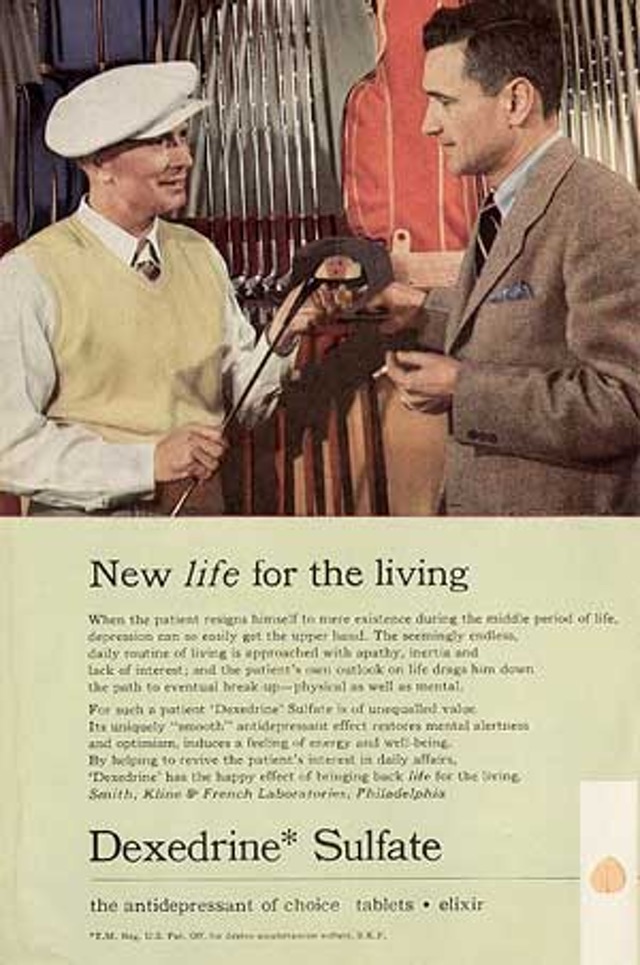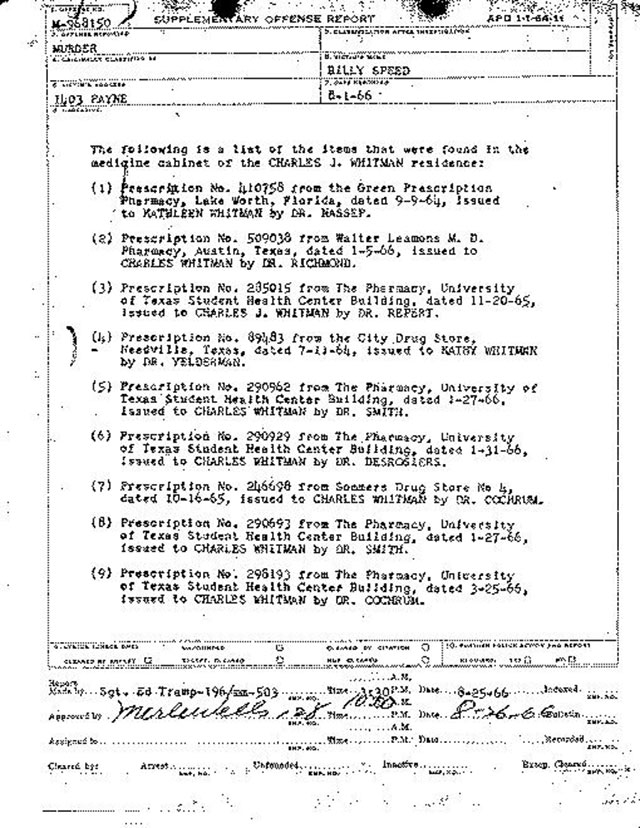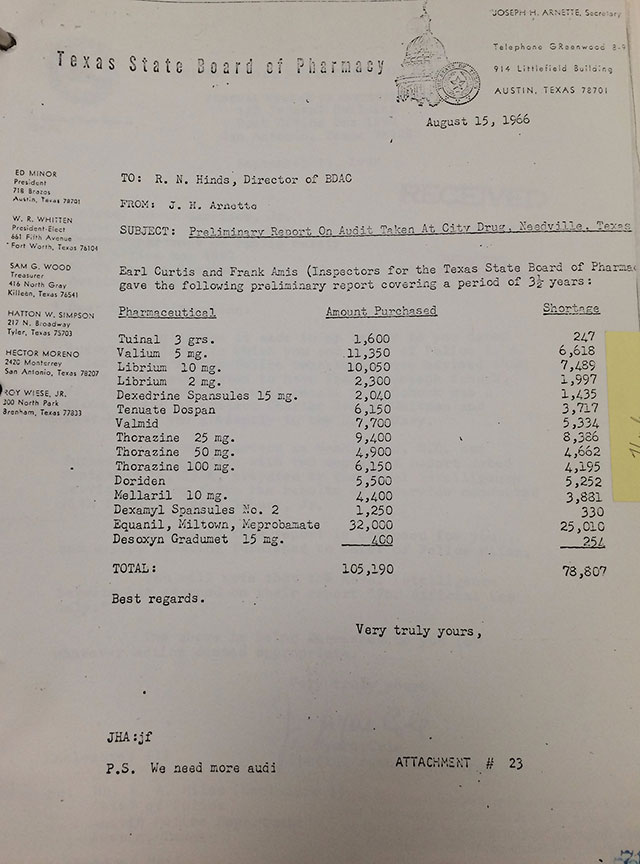There is no evidence that Charles Whitman was under the influence of drugs when he climbed the UT tower on August 1, 1966. An analysis of tissue from Whitman’s liver, stomach, kidney, and brain conducted by the Armed Forces Institute of Pathology turned up negative.1 An expert committee commissioned by Texas Governor John Connally concluded that although Whitman was known to take stimulants as a study aid, “there was no evidence of acute or chronic drug toxicity” on the day of the shootings.2 As A Sniper in the Tower author Gary Lavergne points out, Whitman spent two days planning and executing the murders of his wife and mother, and the mass shooting of dozens of people, with the precision and calculation uncharacteristic of someone affected by an illicit substance.
All of these statements are true. So why even raise the issue of drugs?
There is an enormous gap in the discussion of the UT tower shooting when it comes to Whitman’s substance abuse. The U.S. Food and Drug Administration, Texas Board of Pharmacy, and the Governor’s Commission all investigated whether allegations that he took amphetamines “like candy,” routinely induced insomnia for days on end, and at times exhibited severely compromised cognition and behavior could have had any connection to his actions that day.3 Their findings, particularly of the FDA, are disturbing to say the least - although not why you might expect. Regardless, those inquiries were derailed upon the discovery of the tumor in Whitman’s brain.4 For sure, if there was anything in his body that made him “snap,” it must have been that.

Advertisements for Dexedrine in the 1960s appealed to anyone who simply felt the need for a pick-me-up.
As it turned out, the role of the tumor was just as inconclusive as the role of anything else.5 What’s more, the aforementioned tissue analysis actually tells us very little. Whitman’s body was embalmed prior to his autopsy, severely limiting the findings of any chemical analysis. Dexedrine, his amphetamine of choice, can only be detected through a urine sample, which was wholly unavailable.6 But the Governor’s Report boiled it down to this:
He took stimulating drugs to assist him in keeping academic deadlines, the net effect of which was further loss of efficiency and a decrease in clarity of thinking at these times. However, there was no evidence of acute or chronic drug toxicity on August 1, 1966.7
The role of substance abuse never resurfaced as a line of serious inquiry. Looking back at reports compiled at the time, it’s hard to understand why not.
Days after the shootings, Agent J. W. Hand of the FDA arrived in Austin under the suspicion that “such an extreme act by a hitherto sane individual might be the result of drug abuse.” The investigation was classified as a “stimulant injury investigation” and thoroughly documented Whitman’s habit and its causes, sources, and consequences.8
Friends told Agent Hand that Whitman’s copious drug intake had been “frequent and obvious” over the past few months.9 One, Robert Don McCrary, described Whitman’s daily strategy:
Charles J. Whitman carried three bottles of drugs in his briefcase, these were: (1) the capsules he took to stay awake, (2) tranquilizers for his frayed nerves and (3) aspirin for the headaches he had. Although Charles J. Whitman had these drugs at all times, his most obvious use of them was when he was working against a deadline to submit a project or preparing for an examination.10
Those “capsules” were typically either Dexedrine, an amphetamine, or Dexamyl, a combination of Dexedrine and the depressant amobarbital. Today, Dexedrine is highly effective in treating ADHD. In the mid-1960s, it was widely popular for anything from depression to morning sickness to obesity, and was distributed throughout the military as an endurance enhancer. This last application was what Whitman sought the most. Friends alleged that he routinely used this cocktail to stay awake for multiple days and nights in a row, a pattern that he continued up to August 1. He claimed they were harmless - one friend quoted him as saying “I eat them like popcorn, they won’t hurt you.”11 Yet Whitman did not carry his drugs, as the FDA put it, “in the normal manner of a non-abuser.”12 Instead of storing them in a typical prescription bottle, he kept them in a metal tube. As for his stash at home, investigators opened the family medicine cabinet to find no fewer than eleven prescription bottles made out to Whitman by seven different doctors and filled at five pharmacies.13

The first page of three detailing the contents of the Whitman family medicine cabinet. Image courtesy of Austin History Center, Austin Public Library
It was clear to Whitman’s friends that that his drugs were not entirely safe. Describing him after five days of induced insomnia, Richard Owen Clark said Whitman “was visibally [sic] shaking, he could not hear the normal spoken voice, his ability to reason was impaired, his thinking was slow and you had to shake him to get his attention.”14 The Governor’s Report was spot on when it said the drugs did more harm than good to his ability to study. As McCrary explained:
I observed that Charles Whitman’s thinking was slowed, when with the aid of drugs he had gone without sleep for periods of time. He required three to four hours to do drawings which other students completed in fifteen minutes. The project which he spent five days and nights on was done by other students in approximately three regular working days.15
When taken in doses exceeding those prescribed, Dexedrine can lead to dependence. By the 1960s, amphetamine abuse had reached crisis levels, and physicians knew that it was genuinely addictive. It was precisely in the middle of that decade that calls began to surface for greater regulation of amphetamines in the United States; the regulation of other recreational drugs in the late 1960s and early 1970s followed in their footsteps. In 1969, the University of Texas revisited its own drug policies, eventually implementing measures to expand student access to drug treatment services. An interim report on this effort released on August 1, 1970 (presumably by coincidence), is striking for its almost nihilistic depiction of the contemporary status quo:
However much our culture is basically drug-oriented, as exemplified by daily advertisements inducing the population to take various chemicals to wake us up, reduce our tension, put us to sleep, help us think, or improve our social prestige, it is the opinion of The University of Texas Committee on Drug Policies and Procedures … that reasonable members of an institution of higher learning cannot blindly ignore a rampant increase in drug usage such as our society is currently experiencing.16
Given the relative awareness of the dangers of amphetamine abuse in 1966, it’s difficult to pin down why Whitman’s habit did not raise more of an alarm among his family and friends simply in terms of his general health. FDA interviews revealed that Whitman was quite open about his use of medication to stay awake, and most of his friends and extended family knew what kind he took. The exception may have been his father, who apparently thought he only pills he took were caffeine.
The lack of an alarm is most striking in light of Whitman’s consultation with psychiatrist Maurice D. Heatly. Whitman was referred to Heatly by a physician at the UT Student Health Center in March 1966, complaining that “something was happening to him and he didn’t seem to be himself.”17 Despite the fact that the referring doctor had just issued Whitman a prescription for Valium, there is no mention in Heatly’s report about substances of any kind. Given Whitman’s openness about his drug use with family, friends, and doctors, it is unlikely he would have denied it if asked.18 Why Heatly didn’t bother to inquire boggles the mind. There is too much else about Heatly that also boggles the mind to touch on here; curious minds can read about him elsewhere on this website.
One of the reasons his friends knew about the Dexedrine was that Whitman would offer it to them for free on a regular basis. While amphetamine use was common across the country in the 1960s, distributing it was not. One contemporary study indicated that the vast majority of college students got their “goofballs” from a friend - for some in Austin, Whitman was that friend. As the FDA found out, Whitman’s own source was something much more unusual:19
An effort was made to determine the source of Whitman’s drugs. He apparently had a source not only of amphetamines, but also librium and valium. This tended to indicate a drugstore as the probable Whitman drug source. By further processes of deduction it was suspected that Whitman’s source of drugs may have been the drug store in his wife’s home town of Needville, Texas. He was known to have traded at this drug store.
The Texas State Pharmacy Board, which enforces druggists sales violations in Texas for BDAC, felt that the suspected drug source should be given an immediate audit. […] This audit revealed that the drugstore in the small town (population 900) had significant, unaccountable shortages in dangerous drugs.20
As Kathy’s father Raymond Leissner later told investigators, the Needville drugstore was the town’s primary gathering place, so he saw nothing unusual in the fact that Whitman would go there during each of his monthly visits. He also noted that the store owner, Hugo Frank Ley, Jr., was a close family friend, particularly to Kathy. The report then characterizes the response of Kathy’s mother, Frances Nelson-Leissner, about Whitman’s possible source of drugs as “frequently contradictory or confusing.” Technically, this is true. But this was a mother who days earlier had been robbed of her only daughter by a man she had once told directly: “By trying to completely dominate Kathy you are destroying the very things which attracted you to her in the first place.” Whatever role the Needville Pharmacy may have played in this tragedy, “contradictory” and “confusing” are perhaps the least relevant adjectives to describe Mrs. Nelson-Leissner’s situation. While it is not necessarily the FDA’s job to have sympathy for the unwitting victim of such a twisted, devastating catastrophe, the circumstances were clearly unbearable.

The Texas Board of Pharmacy’s audit of the Needville Pharmacy, run by Leissner family friend Hugo Frank Ley, Jr., revealed a significant shortage in stock.
In the end, the FDA did not establish a definitive connection between Whitman’s substance abuse and the UT tower shootings. It left open the question of whether the prolonged sleep deprivation itself could have been a factor, but his behavior in the days before the shooting was not reminiscent of the stunted cognition his friends had described. Despite some speculation at the time that Whitman suffered from amphetamine psychosis, there is no evidence that he experienced the visual or audio hallucinations characteristic of that diagnosis.
C. Dean Davis, general counsel to the Texas Board of Pharmacy, was less hesitant in his conclusions. Presenting the Board’s findings to a Texas State House committee, he prefaced a similar narrative to the FDA’s:
The following is submitted to the committee as a graphic illustration of the abuse by individuals of amphetamines and barbiturates. The example could be multiplied many times from experiences of police officers throughout the State of Texas and those connected with the Board of Pharmacy pursuant to investigations they have made concerning the use of amphetamines and barbiturates.21
Indeed, Whitman’s level of substance abuse was not unique. At the end of the 1960s, Texas and states across the country found themselves up against a fully saturated black market of largely unregulated pharmaceuticals with demonstrable addictive qualities and dangerous side effects for abusers. But legislators at the time were far more preoccupied with the growing prevalence of LSD.22
Herein lies the lost value of including substance abuse in a broader discussion of the tower shooting. Davis and other advocates of greater regulation were adamant that amphetamine abuse was a national crisis. Whitman’s habit was part and parcel of a dangerously unstable lifestyle, one that he was increasingly unable to control towards the end of his life. It was not behavior that could be subsumed within the label, as Dr. Heatly gave him, of the “all-American boy,” except for in a sickly ironic fashion. Recognizing that Whitman was unquestionably a troubled individual, the Governor’s Report recommended that the University of Texas develop comprehensive mental health and counseling programs. That request was followed through to the hilt. No recommendations were made in regards to substance abuse. If a separate recommendation for a general “health program” was meant to include narcotics, nobody seemed to notice. As noted above, the university only began to revisit its approach to drug policy in late 1969, along with the rest of the country. It seems a lost opportunity that Whitman’s case was not at least used to put a face on the epidemic.
It has taken this country a long time to come to the realization that prescription drug abuse is a crisis that cuts across class and race. Decades of normalization allowed a Caucasian, middle-upper class, male ex-marine to spend four years feeding an increasingly destabilizing drug habit and suffering virtually no social or economic consequences for it. The fact that his drug use was not directly responsible for the tower shooting does not render its existence irrelevant. Ignoring this side of Whitman’s life only helps perpetuate the myth, just now slowly beginning to die, that drug abuse is primarily a problem for minority communities and the poor. If we are to debate whether Whitman was obsessed with guns, suffering from a mental health crisis, the victim of an abominable father, an overbearing domestic abuser, an usurer, a gambler, or an “all-American boy,” then he at least does not deserve our hesitation in calling him a criminal drug addict. He may be all of these things or none of them, but perhaps the least we can do is be consistent.


